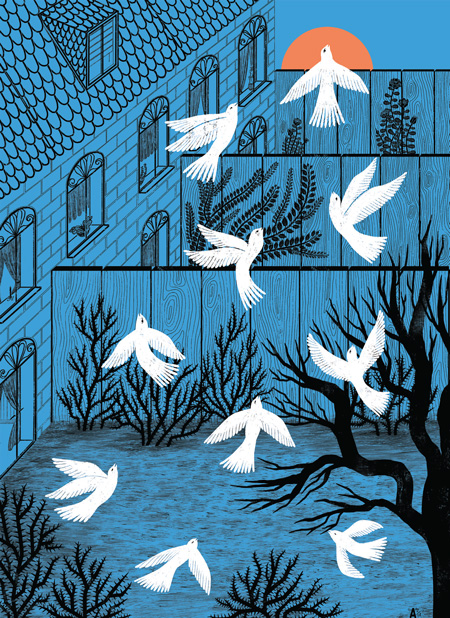
Illustration by Anna Hartwig
This spring, I stood in a seminary’s great hall, gathered with others to honor a beloved professor’s retirement. The crowd included several people whose names were engraved on plaques hanging in the halls or printed on books in library’s stacks.
Those are the people who – outside their hearing – would be described as pillars of theological education in their faith tradition, the stalwarts who helped form generations of a movement’s ministers, missionaries, and scholars. On that day, though, they merely gathered to welcome one more into their fellowship.
Warm smiles welcomed the speeches and only ceded for cake and chit-chat that echoed off the tall walls of the hall, which stretched skyward toward a glass roof some 50 feet overhead, a reminder, perhaps, of the breadth of the work they did and the hope it provided.
The building’s towering walls had stood for only a quarter of a century, belying a much longer tradition of the seminary’s work. The honored professor had taught at the school for 35 years. Some of the invitees in the room pre-dated him, and a few had taught when the professor was in school. And those few had learned from a previous generation of educators who had been seen as their generation’s pillars of theological higher education, people who had passed on and whose names were spoken with hushed reverence.
The words of the Apostle Paul in the second chapter of Ephesians came to mind: Consequently, you are no longer foreigners and strangers, but fellow citizens with God’s people and also members of his household, built on the foundation of the apostles and prophets, with Christ Jesus himself as the chief cornerstone.
The retirement ceremony stood as a living testimony of that passage, and it was just one of many similar rituals repeated in schools across North America, as honored faculty, administrators, and staff were remembered for their sacred work before they moved into retirement or new seasons of life.
These are the people who have made theological higher education what it is. Their sacred work is worth the pause to notice.
These are the people who have made theological higher education what it is. Their sacred work is worth the pause to notice. Since the days of the apostles, theological education has been vital to the health of the church, playing out in countless places in a myriad of ways, often quietly and away from attention. It has taken place on open plains, in caves, on cliffs, in places with walls and without them. The work is difficult.
In a modern seminary’s calendar, there are celebrations of people placed in a liturgical way. The fall is the season of newcomers; the spring is the season of departures – graduations, retirements, moving to other callings. People come to theological schools because they have taken seriously Christ’s call to build disciples. For those who work at seminaries, that means discipling those who will go on to disciple.
It’s a big task, but when the good work is done, and they leave among the litany of those who have faithfully served, they do so with little notice.
Their names may not be known beyond the walls of the seminaries. Their memories may fade as their names are affixed to walls, but their legacy is cemented as new names come to replace them – a generation trained by those who’ve left, another generation ready to pick up the call, and a great cloud of witnesses standing in affirmation.